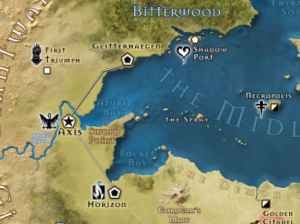 Ok, this Eternal Icons thing is continuing to buzz in my brain, so I’ve started up some further notes on chargen and play.
Ok, this Eternal Icons thing is continuing to buzz in my brain, so I’ve started up some further notes on chargen and play.
It is Known
Characters get two more points for backgrounds, but they must take a reputation at at least +2. Effectively, this is what the other characters (and others) know about the character. It should be true, but if it’s false, then it will be important to communicate the way in which it’s false to the table for reasons which are about to become obvious.
In game, this is a nice hook, but there’s also a meta-purpose for this – it is effectively the summation of the character to be used when bringing players in and out. It is, effectively, a resume. When the player roster shifts, this should say enough about the incoming character to spot any red flags for having the character fit in.
Some tables might want to use classic alignments in this fashion (alignment makes an interesting background[1]) since in many ways it serves a similar purpose. But the bottom line is that it’s a quick sniff test for concept compatibility with a small mechanical hook.
The Divine
The Eternal Kingdom has an official church, rife with ceremony, iconography and appropriate profanity. It is also largely a puppet of the crown, having historically served as a rubber stamp for the King. In his absence, its role may evolve, but that is a matter for your table. In any case, clerics, paladins and the like may absolutely hail from this faith.
It is, however, not the only option. The universe is absolutely littered with gods, ranging from tiny local deities to mighty pantheons. That they exist is not much of a matter of debate, but they are considered rather provincial by the natives of the Eternal Kingdom. Gods tend to be very powerful within their domain, but those domains are usually limited to a single world, and even then, all but the mightiest of them are overshadowed by the Eternal Scions.
Further, gods have a bad habit of thinking themselves the center of the universe, something that doesn’t sit well when the actual center of the universe comes over and punches you in the kidneys. As such, many gods never even try to explore the worlds beyond their own. But there are always exceptions – some travel the worlds for reasons of their own, others seek to spread their influence (always a dicey proposition). Some adapt to their place as small fish in a bigger pond quite adeptly, and there’s a not-insignificant population of gods in the Golden City itself (in both temples and taverns).
Part of this is complicated further by the fact that the line between a god and a being of power is almost entirely ephemeral. One reason that gods are viewed as provincial in the Golden City is that beings of power are so common there that claims of godhood just seem to be putting on airs.
Mind you, there have been gods of sufficient power and scope to demand the attention of the Eternal Kingdom. Many of the stories of the kingdom’s founding include tales of the King casting down and binding various gods, forcing them to bend knee to him. While the details have evolved into legend, this is still an occasional concern, and at time the Eternal Scions have ventured forth to remind a divinity of its place. Of course, as tensions rise within the kingdom, some of these beings may be reconsidering their ambitions.
The Nature of Gods
There is no one answer for what gods are and how they work. Any and all of the possibilities below may be true for some or all gods.
Things that might be true:
- Gods need power from worshipers, with more powerful gods often being more dependent on that worship while more minor gods can get by without it.
- Worshippers do not give a god power so much as reach. Expanding worship of a god to a new world can eventually expand that god’s power to encompass that domain.
- Agents allow a god to act beyond its domain far more effectively than direct action.
- The power of a god is usually tied to a particular place or set of places (Such as a world, or the local cosmology of a world). Within that domain they may be immensely powerful, but outside of it, their power is greatly diminished.
- This is a reason that expanding domains is a real motivator for some Gods.
- Having a foothold in the Eternal Kingdom resonates into power for a god out in the Infinite Worlds, so they are invested in establishing temples, even small ones, in the Golden City and driving traffic to them.
- This is also the reason that Eternal Scions terrify the Gods, because they are capable of destroying entire worlds. Intractable gods have simply seen their homeworlds split asunder by the passing of a Scion.
- Gods are not unique in being powerful, but in their ability to share their power through agents. That power is usually drawn from their domains, so the gods personal power may or may not reflect on the power it offers
- There is nothing that differentiates gods from any other being of power, except the label.
Divine Heroes
Ok, so what does all this mean for clerics? It largely depends on what you want. If, as a player, you just want to serve a remote, abstract power, then you can totally do it. Come up with the name of your god, some trappings, maybe a story of why you’re out in the infinite worlds, and you’re good to go.
But the nature of the Eternal Kingdom allows for another option – in the Eternal Kingdom, there is no reason that gods need to be remote. From a certain perspective, they’re just administrators looking to franchise. It suggests a very different relationship when a cleric needs to drag her god home after a night spent at a dive bar, or when a mercenary paladin is willing to smite in the name of the highest divine bidder. In short, a god may be similar to a patron, with a direct, personal relationship with its cleric, and an agenda to promote.[2]
There’s not a lot of mechanical implications to this, but it’s rich material to draw on one when crafting background or one unique thing.[3] The GM will probably also want to decide which Icons have sway over the God, though this may well be secret.
Divine Villains
This matter-of-fact divinity means that the machinations of gods very easily translate into plots and agendas. Cults are not abstractly evil – they serve specific gods with specific plans, abilities and goals. Gods are, by their nature, power brokers, so it’s easy for them to have their hands in many places.
Gods also make good villains because their power (and threat level) makes them dangerous but still likely to act through agents.
Divine Bargains
It is totally worth stealing the “Roll of the Gods” rules from Questers of the Middle Realms, but in the absence of that, follow the general idea that Gods offer power in return for it being used in their name. Exactly what they gain from the use (power, influence, weakening barriers, whatever) may be a mystery, but the transaction is very straightforward. For players, this might be basis for interesting backgrounds, but this idea is more important for explaining NPC motives and powers.
Gods of Darkness and Chaos
Cthulhu doesn’t have anything going for him over other gods besides very good PR. There are absolutely dark, horrible, sinister gods who would seek to tear apart reality if they could. Thankfully, their influence tends to be limited because they don’t really have a lot to offer to prospective worshippers. Existential threats that reveal the universe is small and uncaring become much less scary when you jump up the scale a step. That said, these dark gods can still be a real threat, especially among the Infinite Worlds.
More dangerous are those gods who actively seek to subvert the Eternal Kingdom. There is something of a loose cabal of divinities who seek to change the status quo throughout the infinite worlds. Their motives are diverse, but they largely offer their followers a vision of something different and better. However, they must act with care – overtly working against the Eternal Kingdom tends to end poorly, but secrecy pairs poorly with worship.
A few gods exist in realms so far removed from the Eternal Kingdom that they can act openly, but their distance also makes any action difficult. For most of the gods of chaos (as they are sometimes called) secrecy is maintained by the assumption of mantles, effectively divine aliases. There is no “Burion, Lord of Abandon”, only a guise taken on by one or more gods.
Were this not such a secret, then some might wonder how exactly they have managed to maintain their divine connection through the mantle, and one might wonder if there is something about these specific mantles that might make them more than mere theatre. But there is no one in a position to ask that question.
Except, of course, for the Icon who provided them.
- Especially for a game that leans more planescape-y. Huh. Will have to remember that. ↩
- By extension, this relationship also tends to illustrate why the god needs the cleric as much as the cleric needs to the god. ↩
- In fact, there’s no reason a character might actually BE a god. It doesn’t help much from day to day, but it may mean they have a place of power out among the worlds. Or perhaps they don’t any more. ↩
